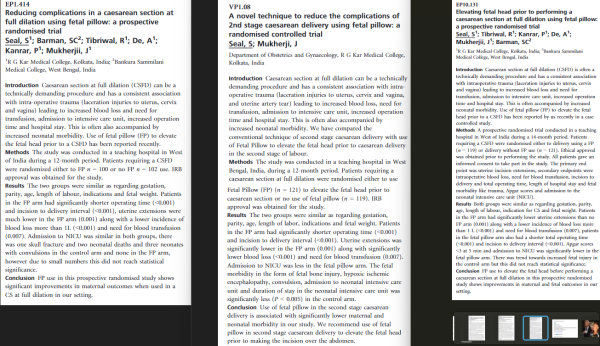River Main; from Bamberg to the Rhine
Flowing east to west for nearly 400 km, I’ve divided the Bamberg to Rhine section into four; Bamberg to Schweinfurt (brewery section), the triangle (Maindreieck), the rectangle (Mainviereck) and finally Frankfurt and the Rheingau. All distances in km from the Rhine junction (click here). There are plenty of official campsites, and although wild camping is verboten in Germany, many tempting spots. One local told me that the authorities turn a blind eye to a single night, but sometimes get forced to act by “busybody Bavarians” – his words! Another that the law defines “camping” as having a groundsheet under you. I was lucky with the weather, pulled up late and laid my bag directly on the ground. No-one complained.
1. Bamberg to Schweinfurt – the brewery section
The Main-Donau canal is not recommended. Although Bamberg is the obvious start, and camping Insel (click here) a lovely site on the Regnitz, about 5 km upstream of the junction, there’s no easy route through Bamberg. The Regnitz right fork, leading to the Main-Donau canal, with little flow in summer, is blocked by a barrage, albeit a possible portage.



The left fork through the hydroelectric power plant in the centre of the Old Town is scenic, but… .






Bamberg old lock is not functioning, but could be portaged via the ferry landing,



The real problem is 6km downstream at Viereth. No sport boat lock and no access. The least bad option would be to land right above the motorboat club and portage nearly a kilometre round the old river loop. Not for me.




Fortunately all other weirs have a sport boat lock, or an easy portage, or both, so I started below Viereth. This upper section is famous for its beer brewing. There are allegedly five breweries in Bamburg alone (click here), and even the smallest town downstream usually has its own.
380.5 km -Viereth lock. Depth 6m. Hydroelectric power station right. 6MW. Launch right bank upstream of the S12262 bridge. Viereth left. Memorial to Michael translates roughly as “Far from the eye… Forever in the heart.”


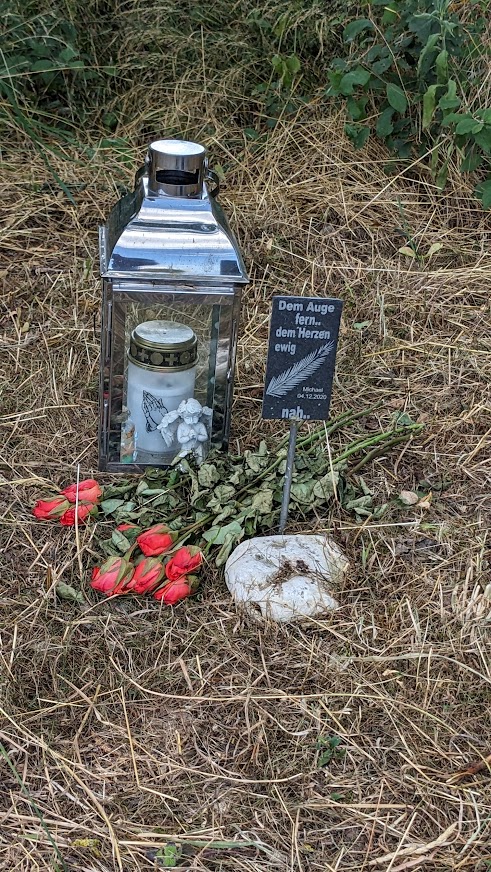

371 km – Eschenbach left. Home to the Eschenbach brewery (click here).



Stettfeld, on the opposite bank, albeit not easily accessible behind gravel pits and the E48 motorway, has the tiny Adler-Brau brewery and bar (click here).



369 km – B26 bridge. Motor boat club, marina, and campsite left 100m before the bridge. Eltmann left. Ebelsbach right. Eltmann’s brewery is Franz Engel. No website but they host a beer festival in July. The Laurenz Krug brewery in Ebelsbach ceased operations in 1991; even Germany has experienced some consolidation. Looks like there was a ferry once.






367.5 km – A70 bridge Followed by 367 km – Limbach lock. Limbach left. Volland brewery closed in 1971. The sport boat lock to the right of the island opens into the original river meander.




363.5 km – Sanderstrasse bridge. Sand left. Zeil, followed by Zeil wharf, right.



0.5 km after the bridge enter the lake via a gap in left bank. The arrow on the sign is ambiguous, but this is the route to Camping am See (click here) at the far end of the lake. Lakeside pitches are reserved for long stay visitors. Overnighters camp near the reception office, 120 metres up the road. There also appear to be plenty of wild camping spots nearer the river.





We are now at the absolute limits of the Franken wine region. The Sander Kronberg vineyard lies in woodland south of the town, well away from the river. Grapes have been grown in Zeil for a thousand years and today there are still a few small vineyards on the south facing “Ziegelander” slopes behind the town. There are also three wineries in Zeil, Martins Klause (click here), Nusslein (click here) and Dr Heigel (click here). Three or four in Sand, Bernhard Rippstein (click here), Thomas Schutz (click here). The day I visited there was a Weinfest, although it looked more like a music festival with crowds, queues and bands.


361.5 km – ST2427 bridge, followed by 360 km – Knetzgau lock right. 4.24 M deep. Hydroelectric power station left 2.9MW.
Lock operation is easy. Talfarht means downstream and Bergfarht upstream. Push the handle to the direction you want the lock to work and press the big button. For safety the big button has to be held down to work the gates. And unnervingly, for those like me who are unsure that they’ve got everything right, there is often a substantial delay before the gate starts moving. If you’re working the lock singlehanded, you’ll need to sit in the canoe while the lock empties, tie it up, climb up the ladder to open the lower gate, and finally climb back down to paddle off. Scary the first time.
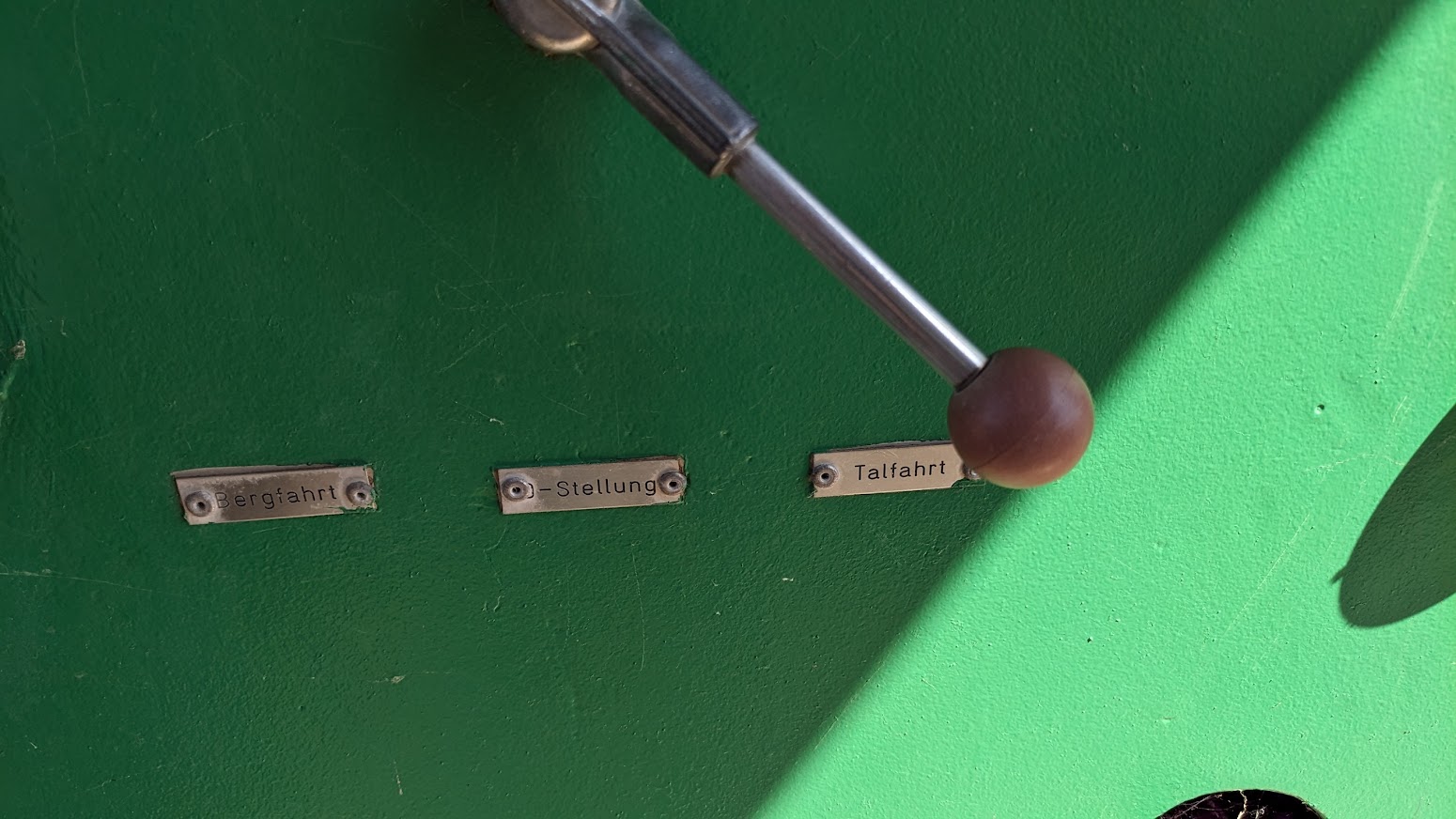
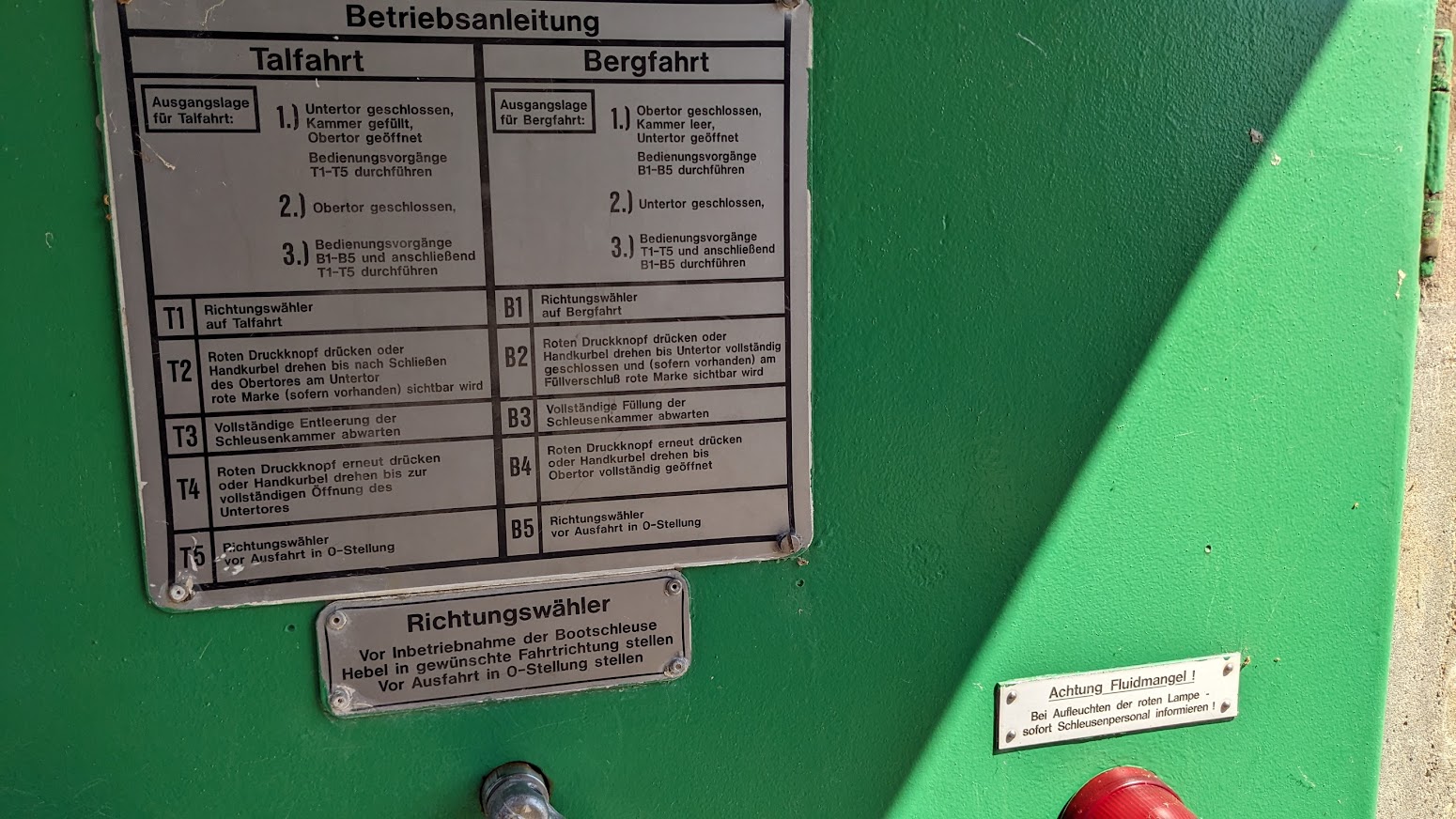




356 km – Camping right bank at Hassfurt (click here). Or land at Hassfurth harbour, followed by 355 km – Hassfurt bridge. The Hassfurt Henneberg vineyard is in the village of Prappach a couple of km to the north east. See Weingut Eller (click here).




354 km – Nassach stream joins right.

349 km – Obertheres motor boat club right. Overnight camping (click here) on the cycle path. Excellent spot. Obertheres right. Followed by 348 km – St2426 bridge



345 km 345 km – Ottendorf lock right. 7.6M deep. Hydroelectic power station left 6.5 MW





344 km – footbridge. Untereuerheim left. Gadheim right. Swallows nesting in the sandbanks




342 km – B303 bridge

338 km – Ferry site, or ford, or Nato ramp. Lidl right. 337 km – Schonungen right. Steinach stream enters right.


335 km Google maps mark Kanu Anlegestelle Mainberg in front of Schloss Mainberg. A good launch spot, but too busy for a wild camp.

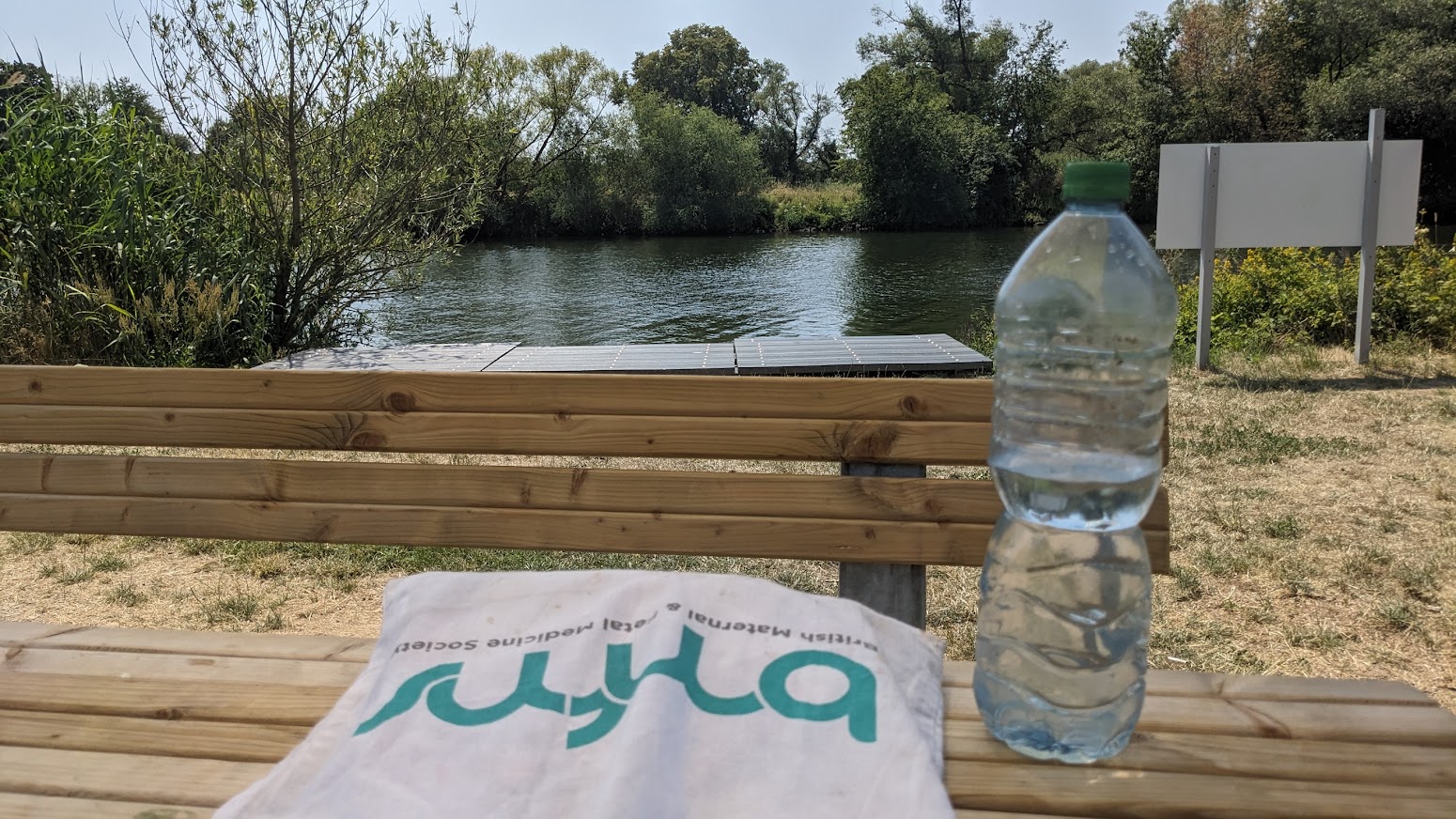

No campsite in Schweinfurt. I bivouacked by one of the distance markers, a few hundred metres before the town.
332.5 km – Max Bridge. Schweinfurt right. 332 km – Schweinfurt big lock left, Island, Hydroelectric power station 3.8MW, weir, Small boat lock right. 4.7M deep. The industrial sculpture on right bank commemorates the world’s first roller dam, installed in the channel at the left end of Max bridge in 1902. I think all the modern dams on the Main are also roller dams.





Turning south at Schweinfurt the river leaves beer country, and enters the Maindreieck or triangle. (Click here for River Main – 2).
Larkin in a thousand words
My first ChatGPT
I entered “The life and works of the poet Philip Larkin in 1000 words” here. 450 came back.
Philip Larkin (1922-1985) was a British poet, novelist, and librarian who is widely regarded as one of the most important voices in post-World War II British poetry. Larkin was born in Coventry, England, and attended Oxford University, where he studied English literature. After graduating, he worked as a librarian at the University of Leicester, the University of Belfast, and finally the University of Hull, where he spent the majority of his career. Larkin's poetry is known for its bleak, often pessimistic tone, and its focus on the mundane aspects of everyday life. He is often associated with the movement known as "The Movement," a group of poets who rejected the avant-garde experimentation of their predecessors in favor of a more traditional, accessible style of poetry. One of Larkin's most famous poems is "This Be The Verse," which begins with the lines "They fuck you up, your mum and dad / They may not mean to, but they do." The poem's frank, unsentimental tone and its focus on the damaging effects of family relationships made it a controversial work when it was first published in 1971. Another notable work by Larkin is his collection "The Whitsun Weddings," which includes the poem of the same name. The collection explores themes of time, mortality, and the passage of seasons, and is widely regarded as one of Larkin's best works. "The Whitsun Weddings" is also notable for its use of vernacular language and its depiction of working-class life in post-war Britain. Larkin's other notable collections include "The Less Deceived," "High Windows," and "Collected Poems." His poetry is characterized by its clarity, its precise and unadorned language, and its ability to find beauty in the mundane. In addition to his poetry, Larkin was also a respected novelist and essayist. His novel "A Girl in Winter" (1947) is a bleak and haunting portrayal of life in wartime England, and his essays, collected in "Required Writing" and "Further Requirements," are celebrated for their wit and insight into the human condition. Despite his literary achievements, Larkin was also known for his reclusive personality and his controversial views on race and politics. In his private life, Larkin was a heavy smoker and drinker, and he never married or had children. He died of cancer in 1985, and his funeral was attended by a small group of close friends and colleagues. In the years since his death, Larkin's reputation has continued to grow, and he is now widely regarded as one of the most important British poets of the 20th century. His influence can be seen in the work of countless poets who have followed in his footsteps, and his legacy continues to inspire new generations of readers and writers.
No Kingsley Amis, Monica Jones or jazz. But not bad. “The movement known as ‘The Movement'” could be rephrased. And surely the F word, rather than the unsentimental tone, made TBTV controversial. But these are quibbles. Let’s try again.
Philip Larkin was a British poet, novelist, and librarian, known for his simple yet powerful language, and for his explorations of themes such as death, love, and the passage of time. Born in Coventry, England in 1922, Larkin was educated at the University of Oxford, where he studied English literature. He went on to work as a librarian for many years, first at the University of Leicester, and later at the University of Hull, where he served as the head librarian from 1955 until his retirement in 1985. Larkin's poetry is often characterized by its stark realism and its unsentimental portrayal of everyday life. His most famous poem, "This Be The Verse," begins with the line "They fuck you up, your mum and dad," and goes on to explore the idea that our childhood experiences can have a profound and lasting impact on our lives. Larkin's work is often bleak and pessimistic, but it is also infused with a sense of dark humor and irony, as he skewers the pretensions and hypocrisies of modern society. One of Larkin's most famous collections of poetry is "The Whitsun Weddings," published in 1964. The title poem describes a train journey from Hull to London on the day of the Whitsun weddings, and it is widely regarded as one of Larkin's finest achievements. The poem captures the sense of excitement and anticipation that pervades the train as it speeds towards the capital, but it also explores the darker themes of mortality and the passing of time. Another of Larkin's most famous poems is "An Arundel Tomb," which describes a medieval tomb in a church in Sussex. The poem reflects on the nature of love and the transience of human life, as Larkin observes that the effigies of the tomb's occupants have been "preserved just so by what they did / And if you look long enough / They will begin to move." The poem has been interpreted as a tribute to Larkin's own parents, who are buried in the same churchyard. Larkin's novels include "Jill" (1946), "A Girl in Winter" (1947), and "The Less Deceived" (1955). Although he is primarily known as a poet, Larkin's prose is also marked by its clarity and economy of expression. His novels often explore the themes of loneliness and isolation, and they are notable for their vivid characterizations and acute observations of human behavior. Despite his reputation as a master of gloomy verse, Larkin was also capable of writing lighter and more playful poetry. His poem "Vers de Société," for example, is a witty and urbane satire on the social mores of the middle classes. Similarly, his poem "High Windows" is a bawdy and irreverent celebration of sexual liberation, in which Larkin declares that "we should be careful / Of each other, we should be kind / While there is still time." Larkin's life was marked by a certain amount of personal tragedy. He never married and had few close friends, and he suffered from depression and anxiety throughout much of his life. He was also deeply affected by the death of his mother, who passed away when he was just 25 years old. Despite these difficulties, however, Larkin continued to produce some of the most important and enduring poetry of the 20th century, and his work remains widely read and celebrated to this day. Philip Larkin died in 1985 at the age of 63, but his legacy lives on in the countless readers and writers who have been inspired by his poetry. His influence can be seen in the work of many contemporary poets, who have taken up his mantle of stark realism and
Less good. He was 55, not 25, when his mother died. “We should be careful…” is from The Mower not High Windows. The Less Deceived wasn’t a novel. An Arundel Tomb is not about his parents, and they weren’t buried in the churchyard.
Humans can still beat AI, just.
Jim Thornton
The Skip
by James Fenton
A friend told me today that this poem had recently cheered up one of his elderly relatives while she recovered from a brush with the orthopods.
I confess I wasn’t familiar with Fenton, but he was friends with Martin Amis and Christopher Hitchens. This photo by Amis’s then girlfriend Angela Gorgas, was taken around the time the poem was written.

That’s good enough for this Amis and Hitchens fan, so I read the poem to my friend. It cheered us both up.
Jim Thornton
The Skip, by James Fenton
I took my life and threw it on the skip,
Reckoning the next-door neighbours wouldn’t mind
If my life hitched a lift to the council tip
With their dry rot and rubble. What you find
With skips is – the whole community joins in.
Old mattresses appear, doors kind of drift
Along with all that won’t fit in the bin
And what the bin-men can’t be fished to shift.
I threw away my life, and there it lay
And grew quite sodden. `What a dreadful shame,’
Clucked some old bag and sucked her teeth: ‘The way
The young these days … no values … me, I blame…’
But I blamed no one. Quality control
Had loused it up, and that was that.
‘Nough said. I couldn’t stick at home. I took a stroll
And passed the skip, and left my life for dead.
Without my life, the beer was just as foul,
The landlord still as filthy as his wife,
The chicken in the basket was an owl,
And no one said: `Ee, Jim-lad, whur’s thee life?’
Well, I got back that night the worse for wear,
But still just capable of single vision ;
Looked in the skip; my life – it wasn’t there!
Some bugger’d nicked it – without my permission.
Okay, so I got angry and began
To shout, and woke the street. Okay. Okay!
And I was sick all down the neighbour’s van.
And I disgraced myself on the par-kay.
And then … you know how if you’ve had a few
You’ll wake at dawn, all healthy, like sea breezes,
Raring to go, and thinking: `Clever you!
You’ve got away with it.’ And then, oh Jesus,
It hits you. Well, that morning, just at six
I woke, got up and looked down at the skip.
There lay my life, still sodden, on the bricks;
There lay my poor old life, arse over tip.
Or was it mine? Still dressed, I went downstairs
And took a long cool look. The truth was dawning.
Someone had just exchanged my life for theirs.
Poor fool, I thought – I should have left a warning.
Some bastard saw my life and thought it nicer
Than what he had. Yet what he’d had seemed fine.
He’d never caught his fingers in the slicer
The way I’d managed in that life of mine.
His life lay glistening in the rain, neglected,
Yet still a decent, an authentic life.
Some people I can think of, I reflected
Would take that thing as soon as you’d say Knife.
It seemed a shame to miss a chance like that.
I brought the life in, dried it by the stove.
It looked so fetching, stretched out on the mat.
I tried it on. It fitted, like a glove.
And now, when some local bat drops off the twig
And new folk take the house, and pull up floors
And knock down walls and hire some kind of big
Container (say, a skip) for their old doors,
I’ll watch it like a hawk, and every day
I’ll make at least – oh – half a dozen trips.
I’ve furnished an existence in that way.
You’d not believe the things you find on skips.
Balloon disimpaction of the fetal head at Caesarean birth
Was NICE fooled?
On 16 November 2022 the National Institute for Clinical Excellence (NICE) published IPG744, Advice on Balloon disimpaction of the baby’s head at emergency caesarean during the second stage of labour. The authors concluded (click here):
New evidence seen by NICE’s interventional procedures advisory committee showed the procedure was safe and effective to be used by maternity staff trained in managing impacted babies’ heads during an emergency caesarean birth.
For the full guidance and supporting documentation (click here).
Three randomised trials were considered. One is behind a paywall, and one in a hard to access journal, but I’ve uploaded pdfs.
Seal SL, Dey A, Barman SC et al. (2016) Randomized controlled trial of elevation of the fetal head with a fetal pillow during cesarean delivery at full cervical dilatation. International Journal of Gynaecology and Obstetrics 133: 178–82 (click here, pdf here).
Sengupta M, Dutta S (2019) A comparative study of maternal and foetal outcome between reversed breech extraction technique and foetal pillow, during caesarean section in full dilatation (CSFD), in second stage of labour. Journal of Evolution of Medical and Dental Sciences 8: 1463–68 (click here, pdf here).
Lassey SC, Little SE, Saadeh M et al. (2020) Cephalic elevation device for second-stage cesarean delivery: a randomized controlled trial. Obstetrics and Gynecology 2020 135: 879–84 (click here, pdf here).
Seal et al. 2016 (click here, pdf here).
The Seal trial was the subject of an extensive critique by Andrew Grey on PubPeer in 2020 (click here). The trial was registered late and may have not had research ethics approval in one of the two recruiting centres. More importantly, an abstract reporting 202 participants was presented at the RCOG world congress in Liverpool on 24th to 26th June 2013 (click here). Although the trial recruited “between April 1, 2013, and March 31, 2014” the closing dates for abstract submission at that congress was 14 January 2013 (click here, screenshot here). i.e. 202 participants were recruited before the trial started!
The same group of authors had previously reported a series of second stage Caesarean births (click here or pdf here) (Andrew Grey paper 3), and a non-randomised study of the fetal pillow with historical controls (click here or pdf here) (Andrew Grey paper 2). Although the series in Andrew Grey paper 2 and the historical controls were the same cohorts, there were a number of differences in the results tables. Grey also identified some significant differences between the control group (no fetal pillow) in the Seal RCT and the doubly reported historical control group from the same centres. See below for the table prepared by Grey
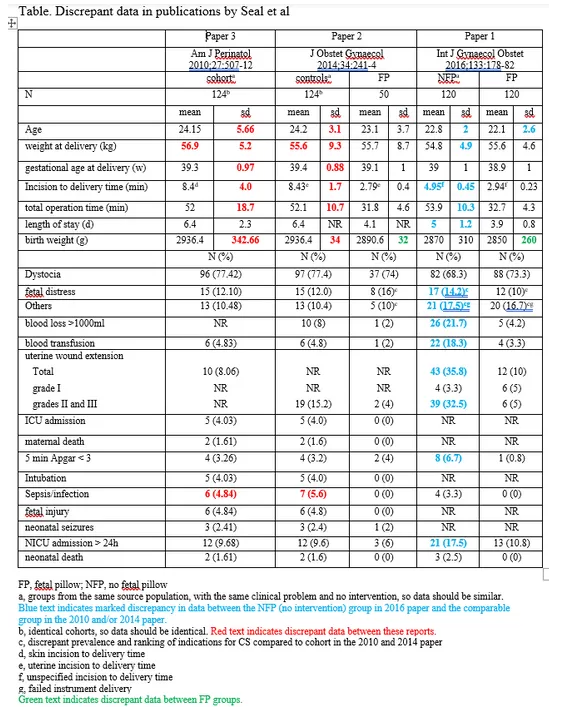
Inconsistency between the two cohorts does not, in itself, invalidate the trial, but some differences between the trial control group and the cohorts are hard to explain. For example mean operation times were almost identical (53.9 v 52 minutes) but incision to delivery time was almost halved in the trial control group (4.95 v 8.43 minutes). Rates of total uterine wound extension were fourfold higher in the trial controls 43 (35.8%) v 10 (8.06%) and severe extensions doubled 39 (32.5%) v 19 (15.2%).
Finally the trial was reported in three separate abstracts, at the RCOG British Congress in Liverpool 2013 as a poster (abstract mentioned above), and at the RCOG World Congress, 2015, 12–15 April, Brisbane, Queensland, Australia (click here) as both a poster and oral abstract (click here). The three abstracts are reproduced below.
The recruitment periods and numbers reported in the three abstracts and the paper are summarised in the following table.
| Liverpool | Brisbane poster | Brisbane oral | Paper | |
| Recruitment period | 12 months | 14 months | 12 months | “Between April 1, 2013, and March 31, 2014” (12 months) |
| Nos. randomised | FP 100 No FBP 102 | FP 119 No FP 121 | FP 121 No FP 119 | FP 120 No FP 120 |
The shorter recruitment period and smaller numbers reported in the Liverpool abstract could be explained if recruitment was incomplete at that time, although there is no mention of an interim analysis. The differences in recruitment numbers in the two Brisbane abstracts and the paper, although small, are difficult to explain.
Andrew Grey’s Pub Peer post, which included other problematic issues, ended with: “These wide-ranging concerns raise very important doubts about the integrity of these 3 publications [the trial and two cohort studies], and the reliability of their findings. They could be addressed by independent scrutiny of the raw data, participant records, and ethics oversight documents.”
Dr Seal replied the same month, October 2020: “We have already responded to the journal editor about the queries. I will respond to your queries as soon as we receive answers from the editor. It may take some times. Thanks Dr subrata lall seal.”
As of November 2022, he has not responded further.
Immediately after Dr Seal’s response, the trial paper’s corresponding & senior author accused Grey and Pub Peer of libel in a long rant, ending with; “We are putting PubPeer on notice to withdraw their defamatory statements and publicise this to limit their libelous damages about our publications and devices.” Two further responses from that person were moderated by Pub Peer.
In summary, at best these data are unreliable and should not be used until the authors explain the inconsistencies and provide a full dataset. At worst the data are fabricated.
Sengupta & Dutta 2019 (click here, pdf here)
The Journal of Evolution of Medical and Dental Sciences is not indexed on Pubmed but the article has a doi through which it can be found on Pub Peer.
NICE treated this as a randomised trial because the section “Data Collection Technique” reads as follows:
“The two techniques were applied simultaneously in the patients. The data was collected in pre-designed and pretested schedule. Randomization was computer generated. Treatment allocation was written on index cards and concealed in identical, sealed, opaque, sequentially numbered envelopes stored in the operating room. After creation of the randomization cards, the computer-generated randomization table was deleted.”
However, the following features suggest that it was probably not a randomised trial.
- The title does not mention randomisation
- The abstract does not mention randomisation. The abstract methods describe it as “a hospital based comparative prospective study”.
- In the main text the study is also described as “Hospital based comparative prospective study”.
- In main text the Sampling Technique is as follows: “Purposive sampling technique consisting of 25 patients in each group, i.e. 25 for Foetal Pillow and 25 for Reversed Breech Extraction Technique
- There is no Consort flow diagram.
- The control group were all delivered by reverse breech extraction, an unusual method for delivering a deeply engaged head, generally used after other methods have failed. This therefore points to purposive sampling of 25 patients delivered this way.
Even if the trial was randomised, the results are problematic. The baseline table, table 1, reproduced below, does not report demographic details by group, but inappropriately adds three P values in the right hand column. It is not clear to what these refer.
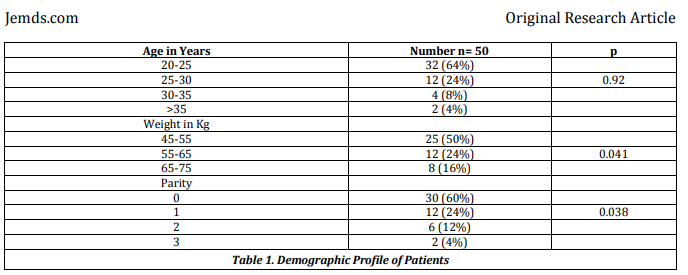
The same issue affects the obstetric variables, table 2, reproduced below.
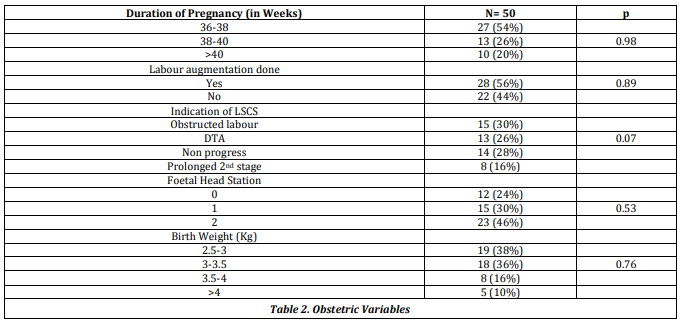
The results table, table 3, reports outcomes by group, but contains incorrect P values, and in two cases incorrect totals for the reverse breech extraction column, shown in red below.
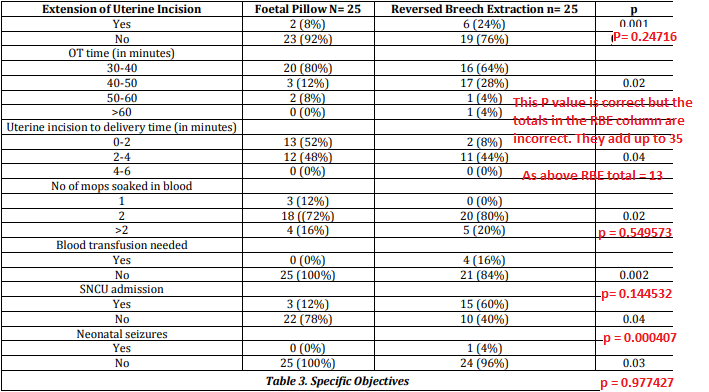
In summary this trial was probably not randomised, and even if it was, the data are not reliable. It should not be relied on, unless the authors can provide an explanation and the original dataset.
Lassey et al. 2020 (click here, pdf here)
These authors report a single centre RCT conducted from January 2018 through July 2019 at Brigham and Women’s Hospital, Boston, Massachusetts. The trial was registered here on 17 November 2017. Planned sample size 200, achieved sample size 60. It’s understandable that trials sometimes don’t reach their target – money runs out, DMECs suspend it, triallists get exhausted – but it’s disappointing that the paper is written as if 60 was the planned sample size all along.
There are other inconsistencies in eligibility, and timing of consent and randomisation. Table below.
| Registry | Paper | |
| Planned sample size | 200 | 60 |
| Eligibility | “both nulliparous and multiparous women” | “Only nulliparous women were included.” |
| Consent | First stage, 2nd stage, or after failed instrumental. “Women will be enrolled from the labor floor during their labor course when there is concern for cesarean section for failure to progress in the second stage of labor. These women may be approached if they have a prolonged labor course (before they reach full dilation), when they get to full dilation and start pushing, or following an unsuccessful operative delivery.” | First stage only “All patients who met inclusion criteria were approached on the labor floor during the first stage of labor” |
| Randomisation | As soon as consent is obtained. “Once consent is obtained, the subjects will then be randomized 1:1 into two parallel groups, the Fetal Pillow Inflated (FPI) group and the Fetal Pillow Not Inflated (FPNI) group. A random number generator will allocate the groups in blocks of ten. | Group allocation revealed to the anaesthetist after the balloon had been inserted and the patient’s legs laid flat. “If cesarean delivery was to be performed in the second stage, women were then randomly allocated to either the cephalic elevation device inflated group or the not-inflated group. An independent consultant created a computer-generated randomization scheme that used balanced treatment allocation in blocks of 10, and the resulting sequential group allocations were kept in sealed, opaque envelopes until time of randomization. At the time of cesarean delivery, the cephalic elevation device was inserted vaginally by the obstetrician after catheterization of the bladder and after vaginal preparation with betadine, per our current labor and delivery guidelines. Once the cephalic elevation device was inserted, the patient’s legs were laid flat on the operating table in accordance with the guidelines for use of this device. The delivering provider and other members of the obstetric team were blinded to whether the device was inflated or not. Group allocation was revealed to the anesthesiologist, who inflated the cephalic elevation device using 180 mL normal saline (inflated group) or did not inflate the balloon (not-inflated group).” |
These ambiguities matter because the consort flow diagram is inadequate. It simply records that 60 eligible women were randomised into two equal groups of 30. There is no mention of compliance with treatment allocation, losses to follow up or any of the myriad of other problems one would expect to arise in a trial of this complexity, conducted during an emergency second stage Caesarean section. In two cases the Caesarean followed a failed instrumental delivery, and in 14 there was also a non-reassuring fetal heart rate pattern.
To summarise, NICE has recommended that the fetal pillow is safe and effective, on the basis of one probably fabricated trial, one trial which was probably not randomised, and a third tiny trial, which failed to achieve its planned sample size and had a number of other worrying inconsistencies between registration and the final paper.
I’ve written to all three corresponding authors requesting trial source data.
Jim Thornton
Update. The Seal trial was retracted by Int J Gynecol Obstet in June 2023 (click here) and NICE reverted to its (2015) guidance the same month (click here). In brief, this describes the evidence as “inadequate in quantity and quality” and recommends use of the balloon only “with special arrangements for clinical governance and audit or research”. Good advice.
Prolific data fabricator
Mohammed Rezk from Menoufia
Dr Mohammed Rezk is Assistant Professor of Obstetrics and Gynecology at Menoufia University in Egypt. He has 71 publications on Google scholar, including 17 RCTs and 34 cohort studies. My colleagues and I first became aware of his work through two trials.
- Rezk M, Emarh M, Masood A, Dawood R, El-Shamy E, Gamal A, et al. Methyldopa versus labetalol or no medication for treatment of mild and moderate chronic hypertension during pregnancy: a randomized clinical trial. Hypertens Pregnancy. 2020;39(4):393-8.
- Salama M, Rezk M, Gaber W, Hamza H, Marawan H, Gamal A, et al. Methyldopa versus nifedipine or no medication for treatment of chronic hypertension during pregnancy: A multicenter randomized clinical trial. Pregnancy Hypertens. 2019;17:54-8.
Despite being allegedly different trials both recruited over the identical time period in the same hospital, and many result values were either identical, or within a single digit of each other – see PubPeer comment (here). No satisfactory explanation was forthcoming, and each journal eventually published an expression of concern (click here and here).
There was another unusual feature. In Rezk 2020, 69/70 categorical variables were even numbered, and in Salama 2019, all 75 were even. The probability of this happening in real data is extremely low. The same even number excess is a feature of many of his other papers (e.g. here. Tabulated here).
We were not the first to notice this. Retraction Watch recently reported that in 2017 John Carlisle, the famous fraud buster, had noticed an excess of even numbers in a trial submitted by Dr Rezk to Anesthesia (click here). He declined to publish the paper, got an evasive reply to his request for original data, and no reply at all to his request for Menoufia university to investigate. Others independently noted an excess of numbers in multiples of 5 or 10 (click here and here).
Rezk was not only undeterred – he has published 30 more papers since being called out by Carlisle – but he doesn’t seem to learn either. At least nine of these later papers contain the same highly improbable excess of even numbered categorical variables.
Last year we reviewed all 51 of Dr Rezk’s clinical papers (here or preprint). At least 35 have problems, of which to date four have been retracted, and a further eight have a published expression of concern.
If all 35 were retracted, he would be 16th equal on the Retraction Watch leader board (click here). With 51 he would make 9th place.
Jim Thornton
Monkeypox in pregnancy
Original sources
Original scientific reports of monkeypox in pregnancy. Summaries, links, full texts, & citations, along the lines of our Covid-19 database (click here). No opinion, reviews, or guidelines. Just primary sources. Regularly updated by Susan Bewley, Keelin O’Donoghue, Kate Walker and me.
We’ve not listed primary sources for smallpox vaccine in pregnancy, but see reference list of study 10.
30 July 2022 – MP study 11 added
MP study 11 – a monkeypox & pregnancy registry
A group from Switzerland who run a registry for emergent infectious pathogens and pregnancy (click here) have expanded it to collect cases of monkeypox in pregnancy (cleck here or study). Citation: Pomar L, Favre G, Baud D. Monkeypox infection during pregnancy: European registry to quantify maternal and fetal risks. Ultrasound Obstet Gynecol. 2022 Jul 9. doi: 10.1002/uog.26031. Epub ahead of print. PMID: 35809242.
13 June 2022 – MP studies 7 to 10 added
MP study 10 – 376 women in smallpox vaccine in pregnancy registry
As of September 2006, pregnancy outcome data were available for 376 women enrolled in the Smallpox Vaccine in Pregnancy Registry (click here or study). Rates of pregnancy loss (11.9%), preterm birth (10.7%), or birth defects (2.8%), were judged comparable with those in healthy referent populations. No cases of fetal vaccinia were identified. Citation: Ryan MA, Seward JF; Smallpox Vaccine in Pregnancy Registry Team. Pregnancy, birth, and infant health outcomes from the National Smallpox Vaccine in Pregnancy Registry, 2003-2006. Clin Infect Dis. 2008 Mar 15;46 Suppl 3:S221-6. doi: 10.1086/524744. PMID: 18284362.
MP study 9 – 13 pregnancies in studies of Imvanex vaccine
Thirteen pregnancies occurred during five studies of Imvanex smallpox vaccine (Live Modified Vaccinia Virus Ankara). One was terminated with an elective abortion and one ended as spontaneous abortion. All others were followed up and all women gave birth to healthy babies (click here or study p109). These cases may overlap with those in study 7. Citation: European Medicines Agency 369203/2013 Committee for Medicinal Products for Human Use (CHMP) 30 May 2013. Accessed 13 June 2022
MP study 8 – no data on tecovirimat in pregnancy
Tecovirimat SIGA is indicated for the treatment of orthopoxvirus disease (smallpox, monkeypox,
cowpox, and vaccinia complications). There are no data on its use in pregnant women (click here or study p 30). Citation: European Medicines Agency 703119/2021. Committee for Medicinal Products for Human Use (CHMP)11 November 2021. Accessed 13 June 2022
MP study 7 – 14 pregnant women in trial of live, non-replicating smallpox and monkeypox vaccine
In this Federal Drug Administration report 24 women became pregnant during controlled trials of the Live, Non-replicating Smallpox and Monkeypox Vaccine, Modified Vaccinia Ankara BN (MVA-BN). 14 had received active vaccine or placebo. Five gave birth to healthy infants, and three had elective (non-medically indicated) abortions. In the MVA-BN group one had fetal death at ~12 weeks and one had a spontaneous abortion. In the placebo group, two had spontaneous abortions. Four women were lost to follow-up and the pregnancy outcomes are unknown (click here or study p 123). Citation: JYNNEOS, also referred to as Modified Vaccinia Virus Ankara–Bavarian Nordic (MVA-BN) FDA biologics license application. Clinical Review Memorandum 9/19/2019. Accessed 13 June 2022
11 June 2022 – MP study 5 added
MP Study 6 – five cases from the Democratic Republic of Congo
This preprint includes five pregnancy cases (click here or study), of which four had been previously described in MP study 1. No details are given of the new case except that this sentence in the abstract “fetal death occurred in 4 of 5 (80%) patients who were pregnant at admission” implies that the fetus died. Citation: Phillip R. Pittman, James W. Martin, Placide Mbala Kingebeni, Jean-Jacques Muyembe Tamfum, Qingwen Wan, Mary G. Reynolds, Xiaofei Quinn, Sarah Norris, Michael B. Townsend, Panayampalli S. Satheshkumar, Bryony Soltis, Anna Honko, Fernando B. Güereña, Lawrence Korman, John W. Huggins. Clinical characterization of human monkeypox infections in the Democratic Republic of the Congo. medRxiv 2022.05.26.22273379; doi: https://doi.org/10.1101/2022.05.26.22273379
8 June 2022 – MP studies 1-5 added
MP study 5 – No cases in pregnant women in present outbreak
As of 4 June 2022 no cases of monkeypox in pregnant women have been reported by WHO, either in endemic or non endemic areas (click here). Note the report does not explicitly state that no cases in pregnancy have ocurred. Citation: The World Health Organisation. Multi-country monkeypox outbreak: situation update. 4 June 2022. Accessed 8 June 2022
MP study 4 – no pregnant women in the 2003 USA outbreak
No infected pregnant women were reported in any of the CDC reports of the 2003 United States outbreak of monkeypox (click here for the latest update). Citation: Update: multistate outbreak of monkeypox—Illinois, Indiana, Kansas, Missouri, Ohio, and Wisconsin, 2003. MMWR Morb Mortal Wkly Rep 2003;52:589–90.
MP study 3 – secondary source for a case report from Zaire
“One case of probable congenital monkeypox in Zaire has been described. At approximately 24 weeks of
gestation, a pregnant woman developed a febrile illness with a rash; monkeypox virus was subsequently isolated from a vesicular lesion. Six weeks later she delivered a 1,500-g female infant with a generalized skin rash resembling monkeypox. The child died of malnutrition at 6 weeks of age.” The source is given as Jezek Z, Fenner F. Human monkeypox. New York (NY): Karger; 1988. [Not accessed]. Citation: Jamieson DJ, Cono J, Richards CL, Treadwell TA. The role of the obstetrician-gynecologist in emerging infectious diseases: monkeypox and pregnancy. Obstet Gynecol. 2004 Apr;103(4):754-6. doi: 10.1097/01.AOG.0000114987.76424.6d. PMID: 15051569.
MP study 2 – one case from Nigeria in 2017-18
One woman who was pregnant during her illness had a spontaneous abortion at 26 weeks (click here or study). Citation: Yinka-Ogunleye A, Aruna O, Dalhat M, Ogoina D, McCollum A, Disu Y, Mamadu I, Akinpelu A, Ahmad A, Burga J, Ndoreraho A, Nkunzimana E, Manneh L, Mohammed A, Adeoye O, Tom-Aba D, Silenou B, Ipadeola O, Saleh M, Adeyemo A, Nwadiutor I, Aworabhi N, Uke P, John D, Wakama P, Reynolds M, Mauldin MR, Doty J, Wilkins K, Musa J, Khalakdina A, Adedeji A, Mba N, Ojo O, Krause G, Ihekweazu C; CDC Monkeypox Outbreak Team. Outbreak of human monkeypox in Nigeria in 2017-18: a clinical and epidemiological report. Lancet Infect Dis. 2019 Aug;19(8):872-879. doi: 10.1016/S1473-3099(19)30294-4. Epub 2019 Jul 5. PMID: 31285143.
MP study 1 – four cases from the Democratic Republic of Congo
Four pregnant women treated in the General Hospital of Kole, in Sankuru District, Kasai Orientale Province, from March 2007 to July 2011. One was infected at six weeks (miscarriage at 9 weeks), one at 6-7 weeks (miscarriage at 8-9 weeks), one at 14 weeks (livebirth at term), and one at 18 weeks (fetal death at 21 weeks) (click here or study). Citation: Mbala PK, Huggins JW, Riu-Rovira T, Ahuka SM, Mulembakani P, Rimoin AW, Martin JW, Muyembe JT. Maternal and Fetal Outcomes Among Pregnant Women With Human Monkeypox Infection in the Democratic Republic of Congo. J Infect Dis. 2017 Oct 17;216(7):824-828. doi: 10.1093/infdis/jix260. PMID: 29029147.
Заповіт Тараса Шевченка
The tenth translation of Testament by Taras Shevchenko
The New Yorker’s May 9th issue includes two factual reports from the town of Bucha, outside Kyiv; James Nachtwey’s photo portfolio, “A Harrowed Land” (click here), and Luke Mogelson’s “The Wound Dressers” (click here).
A shell-shocked widow retrieves a book of poetry from a box under the bed in her ruined home. Nina and Lyudmyla, sisters in their seventies, lie dead in a different house. Their shelves contain the same collection.
Mogelson writes:
Widely considered the progenitor of modern Ukrainian literature, Shevchenko had contributed as much as anyone to the development of modern Ukrainian identity, distinct from Russia’s. “My Testament”, one of the poems in the book, had become a kind of anthem for protestors during the Revolution of Dignity.”
There are at least ten English translations; eight here, a ninth here. But the latest, included in The Complete Kobzar, The Poetry of Taras Shevchenko by Peter Fedynsky (click here), is not on the internet. In contrast to the rhyming original, it’s in free verse. Fedensky claims to have followed only two rules, “strict adherence to the meaning of the original, and a constant rhythm, […] facilitated by the rich vocabulary of English.” Here it is.
Testament by Taras Shevchenko When I die, then bury me Atop a mound Amid the steppe's expanse. So I may see The great broad fields The Dnipro and the cliffs, So I may hear the river roar. When it carries hostile blood From Ukraine into the azure sea... I’ll then forsake The fields and hills - I'll leave it all Taking wing to pray To God himself... till Then, I know not God. Bury me, rise up, And break your chains Then sprinkle liberty With hostile wicked blood. And in a great new family, A family of the free, Forget not to remember me With a kind and gentle word.
Cocktails for Ukraine
And poems
Soon after the first lockfown, inspired by Stanley Tucci (click here), I started filming drinks recipes (click here) for friends who missed our usual walking and canoe trips. Sometimes I added a poem. At the end of each week we zoomed, grumbled and had a cocktail.
One (click here) managed a hundred views, mainly because The Philip Larkin Society noticed it. The first verse of Sympathy in White Major is the best poem ever written about a gin & tonic. It may be the only poem written about a gin & tonic! The rest sank without trace.
Only one, the alcohol-free Nogroni (click here), deserves to be watched again, and that because my grand-daughter stole the show.
Last week, when Ukraine was invaded, I tried my hand at a Volodymyr Zelensky (click here) in honour of their brave president. Intending to be humorous, I ended on a serious note and choked up. Too lazy for a retake, it’s already had over a thousand views. A lot for me.
Yesterday The Dirty Ukranian (click here). The 5:1 ratio reminds us of Ukraine’s numeric disadvantage, and the salty pickle how bravery, morale and leadership will more than make up for it. The crocuses & daffodils supported, Tania filmed and Susie toasted. I forgot to read Auden’s poem on the 1968 Soviet invasion of Czechoslovakia.
Za nas, za vas, i za Donbas!
August 1968
The Ogre does what ogres can,
Deeds quite impossible for Man,
But one prize is beyond his reach:
The Ogre cannot master Speech.
About a subjugated plain,
Among its desperate and slain,
The Ogre stalks with hands on hips,
While drivel gushes from his lips.
W.H.Auden
The last specialty using racist charts
Deriving normal ranges from abnormal patients
Doctors do millions of different tests on patients – bloods, imaging, exercise tolerance – and always define the range of normal values on healthy people. The normal haemoglobin concentration is based on healthy participants. Even in countries where malaria is common, and many people anaemic, the same normal ranges are used.
With two exceptions, renal function and fetal biometry. Until recently some kidney doctors used different estimated glomerular filtration rate (eGFR) ranges for people with black skins, who tend to have lower values, i.e. slightly worse renal function. And some obstetricians still use special “customised” fetal size charts, for short, underweight, or ethnic minority mothers, who tend to have smaller babies.
However the lower black eGFR values are not “normal”, they reflect more pathology, raised blood pressure etc. In 2021 NICE recognised that using different normal ranges for black people was racist. It deprived them of effective treatment, and NICE revised its guidelines to a single set of normal ranges for all adults (click here).
Most obstetricians also know that being short, under or over-weight, or having dark skin, is also associated with adverse outcomes, so using special charts for such women tends to normalise pathology. Their use is heightist, weightist and racist. The WHO, and the Intergrowth-21 group, have produced unified charts based on healthy pregnancies, which most obstetricians worldwide now use.
But the UK has been slow to adjust. About half of UK maternity units still use customised charts and the RCOG, in its Green Top guidelines, still endorses them (click here).
In the 1970s Archie Cochrane awarded obstetrics the “wooden spoon” as the last specialty to implement evidence-based medicine. We’ve done better in that department since.
But right now we are the last specialty using racist charts. Fortunately the Green Top guidelines are due for revision. It’s time to put this right.
Jim Thornton
Two maternal deaths from surgical herpes
Avoidable with blunt needles
Last year a BBC investigation suggested that two young women in Kent had died from generalised surgical herpes infection, contracted from an infected surgeon, due to a needlestick injury at Caesarean section (click here).
The evidence was compelling. Herpes contracted this way is rare, but often fatal. Neither woman had a previous history of herpes, so would likely not have had prior immunity. Both were operated on in the same trust, albeit different hospitals, by the same unnamed surgeon. Kim Sampson gave birth on 3 May 2018, and Samantha Mulcahy on June 26 the same year. Both developed overwhelming herpes infections shortly after birth and died soon after.
According to emails seen by the BBC, the partial viral genome from both infections was not only identical, but also “rare”, compared with the previous 10 years of herpes samples collected by Public Health England’s North London lab. Although the surgeon was questioned, and denied having a herpetic lesion (a whitlow) on his finger, such lesions can be small and missed.
Needlestick injuries at Caesarean are common – the BBC quotes a 50 percent glove perforation rate. It was not reported whether the surgeon used a sharp or blunt needle, but the former is likely. If so, an easy opportunity to prevent the deaths of two young women was missed.
There is overwhelming evidence that blunt needles reduce needlestick injuries. It not only accords with common sense, but there have been ten randomised trials, two involving Caesarean section, and 2,961 operations included in the latest Cochrane review in 2011 (click here).
The use of blunt needles reduced the risk of glove perforations (RR 0.46; 95% CI, 0.38 to 0.54) compared to sharp needles, and self‐reported needle stick injuries (RR of 0.31; 0.14 to 0.68). It is unlikely that future research will change this conclusion.
This was followed by a Cochrane editorial (click here) in which the review was cited as an example of one “that can and should change practice”. The authors wrote “where they can be used they should be used”. They are recommended by the US Centers for Disease Control, the US Food and Drug Administration (click here), and the National Institute for Occupational Safety and Health (click here)”.
However, for some reason, NICE (click here for the March 2021 guidance), still doesn’t recommend them, and in my experience, few UK obstetricians use them. Despite the FDA and CDC recommendations things are not much better in the US. In a recent survey only 17% of fetal medicine trainees used them, and many were not even aware such needles existed (click here).
The reason for such reluctance to implement a simple safety step is unclear. They need a little more pressure to penetrate tissue, and some surgeons argue, mistakenly, that needlestick injuries matter less when everyone is screened for Hep B, Hep C and HIV. Nothing could be further from the truth. Each of these viruses caused many surgical infections until screening caught up, and if the last two years have taught us anything, new viruses are appearing all the time!
The inquest opened this week (click here) and has been adjourned to February 21. Let’s hope the coroner, Ms Katrina Hepburn, asks if the surgeon used blunt needles, and if not, why not.
This is an avoidable harm. If NICE’s recommenation had been evidence-based, maybe two young women would be alive today.
Jim Thornton

